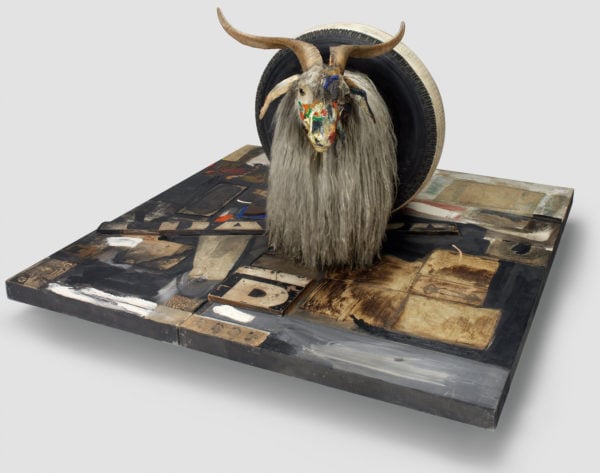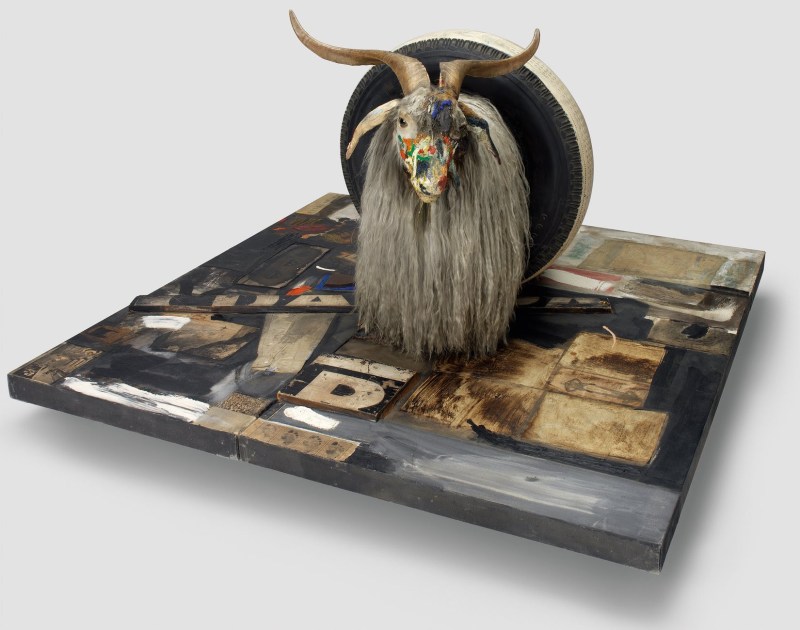
It was on one knee, while I gazed with eager intensity at abstract expressionist Robert Rauschenberg’s “Monogram” (1955-59), that I realized I was experiencing visceral joy.
Mind you, this joy was not a product of being eye level with a literal goat (enveloped mid-way up by a cumbersome tire and entirely splattered in paint). It wasn’t produced by the glint of the goat’s eye, by each of his individually preserved hairs or by the dirt resting in the tire treads I was sure had remained intact since conception. Neither was it from the large glass encasing which separated Rob’s vision—what he had handled and felt and molded years prior in a past I could never touch fully—from my two looming irises. No: This vibrant burst of elation was consuming me from a simple, perhaps even the simplest act: the act of looking.
Robert Rauschenberg’s name first wound its way into my head-space last autumn quarter, while seated (ecstatically) in Professor Alexander Nemerov’s Art History 1B survey course. However, I must confess, that introduction to Rauschenberg’s work did not quite do what, as a score of other artists had already, done for me. I was intrigued, my curiosity most certainly raised its head to stare; but Rauschenberg’s dark and dirty wooden structures, confused with paint and newspaper collages, did not ring as beautiful.
Regardless of the mild tone Rob struck me with initially, I still held his name close, an object entirely worthy of being treasured. It was not unreasonable, then, that as I approached the San Francisco Museum of Modern Art’s new retrospective on Rauschenberg this December (the exhibit is up until March 25), I did so with contained excitement. Striding confidently through the layered walls of the building, I wound my way to the entrance of the exhibit. There, Rob took me gently by the hand, and we were off…
I fell in love in the autumn of my freshman fall with several men (and some women, though not nearly enough) all at once. Indeed, while many (in fact, almost all) of my friends entered CS106A, B or X (?!?), I was daydreaming of the sheer extravagance of Rubens, Rothko’s divine color blocks, the anger inside Clyfford Still’s jagged brush strokes. I fell head over heels for Art History, sitting inside Cubberley Auditorium, three times a week for two quarters straight. The year progressed; my intense devotion followed. Never had I admired a subject with as much vigor. But sitting in the little gaping heart of Silicon Valley, this love was tinged with unease, with a hesitancy I found repeatedly disgusting. From fielding questions about my future job prospects or career options posed by my parents, family and friends, to sitting by myself wondering, of all things, why I had to love such a subject so much—I felt enormously conflicted.
Enter Rob Rauschenberg, several quarters later. The exhibit at SFMoMA led as many others do: Rauschenberg’s prominent works were noticeable to me instantly from Art History 1B, but the other pieces continued to jump as well. After leaving “Monogram” (reluctantly, I might add, though my knee hurt from prolonged bending), I came face-to-face with “Bed” (1955): an actual bed posted upright on the wall, screened behind glass, complete with a pillow and coverlet half pulled back, entirely covered in splatterings of paint. The piece, suspended as if in a dream that the artist was in fact still dreaming, sang to me of an expected faithfulness. I could see Rob, folding the sheet with care, tucking in it, a mother to his own ambition. I adored it, and him. And I adored looking at what his imagination wrought. Looking at the beauty that someone produced of his own derision, without pull from any type of social-career-based demand, without a care for the life he ought to pursue…simply, a bed full of daydreams suspended on a wall in one of the most noteworthy museums in America. It destroyed me.

This destruction continued to dance beside me as I wound my way through SFMoMA’s white-washed walls. Rob gave me the unexpected, the understated and the ceremonious. He also gave me the exceptionally weird, something I encountered when abruptly turning a corner—in which lay only, and most literally, a pool of bubbling mud, aptly named “Mud Muse” (1968-71). What? Encased in a glass-like, Frankensteinian tank, this enormous tub of mud was hooked up to a timer Rauschenberg designed himself, spluttering and popping on command. At first deterred by this complete oddity—this vat seemed out of place, leering, midst the otherwise canvassed and brightly colored pieces on display—as I spent more time with the broiling thing, I became more accepting. The mud, being set on a timer to pop and bubble and exist in an animated fashion, had been doing so since Rob flipped the switch on. And, most intriguingly, it was the same mud it had always been! Curious and tentative, I imagined the approach: Rob, artist turned mud excavator, having men pour gallons of dirt and water into a vast tank that he then made into a rhythmically designed series, his own popping orchestra. It was, I think, perhaps the only time mud has ever truly charmed me.
But what, really what, was so appealing to me about all of this sometimes seemingly incompatible work of Rauschenberg’s? Why would this matter? We look at things—faces, sidewalk cracks, candy wrapper trash— everyday. Why Rob? Why his goat?
As a student devoted to the humanities at a largely technology-centric school, I’ve often felt excluded from the STEM student’s typical idea of a successful academic (and, presumably, future) career at Stanford. Or anywhere, really. Art History doesn’t quite fit that particularly stark-white, smooth-edged bill. And this, to me, is terrifying. Not because set ideas of success are always gruesome spectacles, but rather because they tend to tear down dreams of unconventional routes to that same success. As someone deeply in love with books, writing, and words, the notion that a creative path could be blocked by something as meager as convention is abhorrent. How, then, to name a pursuit as being a worthy one to begin with? How to make someone else respect what you adore?
Leaving the exhibit, I mused over its title: “Erasing Time.” Checking my watch, I realized I had wandered alongside Rob for nearly an hour. And time had let me. It had allowed me to stand still with someone already dead, to rest my gaze upon an imagination that, though no longer functioning actively, still lived. The mud was his original mud. The frozen goat, the same one he chose. The beautiful thing about the Rauschenberg exhibit is that it went beyond the act of preservation; it did not simply present relics of a past, it gave them the freedom to breathe, to bubble, to stare down strangers in a wide, white space. And I loved it. The eager intensity I felt upon meeting with Rob’s goat never left. It followed, a personal shadow, as I tilted my head and looked and looked and looked. This shadow—Rob’s own hand pressing me onwards, onwards further into a living imagination—spoke a song of re-animation, of time suspended until I myself took the time to enter such suspension with it. And this is how art lives, too. It sits, time erased, an object eternal and pressing and complete, waiting for viewers to breathe life into it again through the act of looking.
Rob brought me joy. I am going to continue to follow that joy, full-throttle. This, for me, shall be enough. Imagine only: Sisyphus, happy!
Contact Mac Taylor at ataylor8 ‘at’ stanford.edu.
